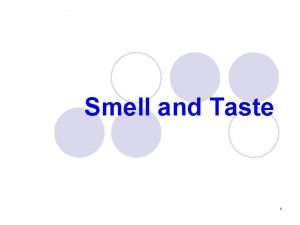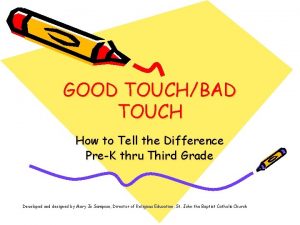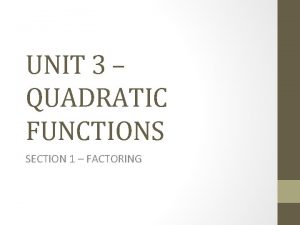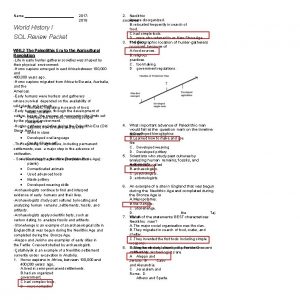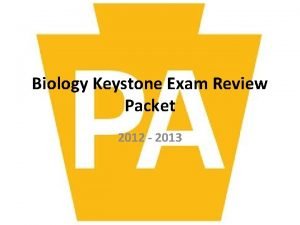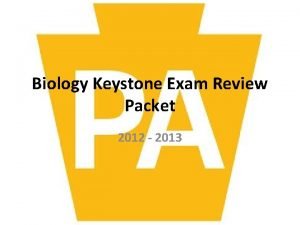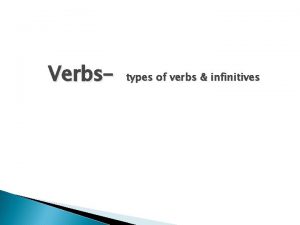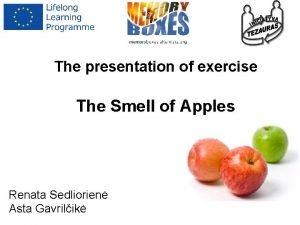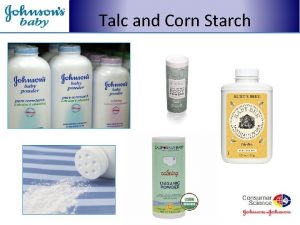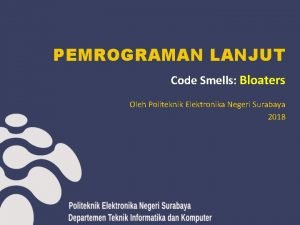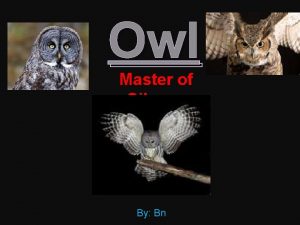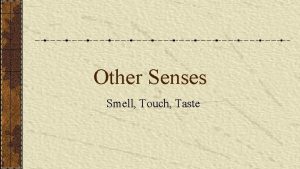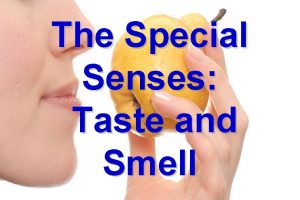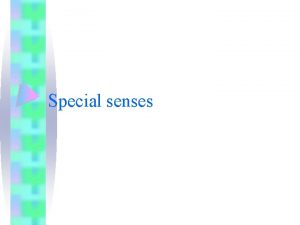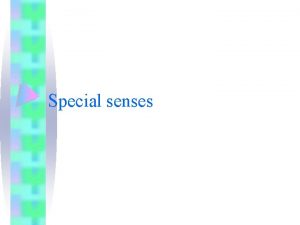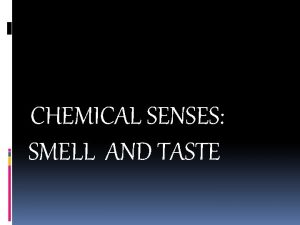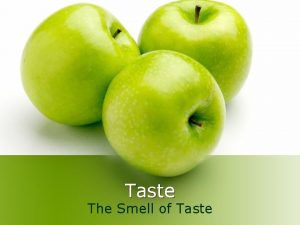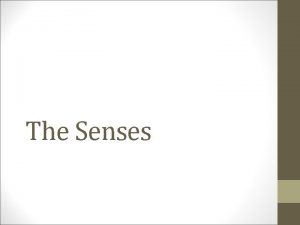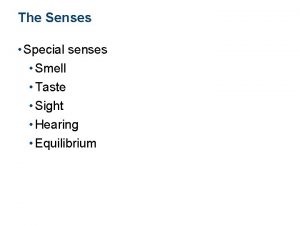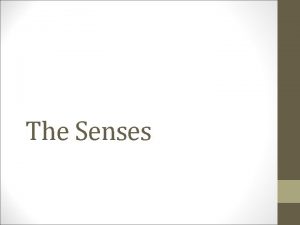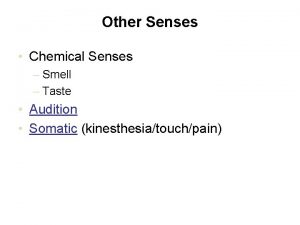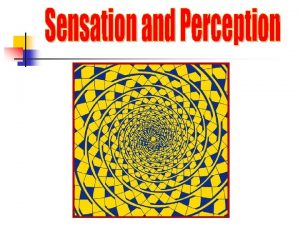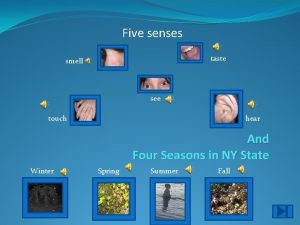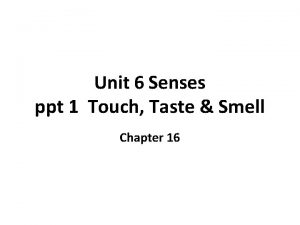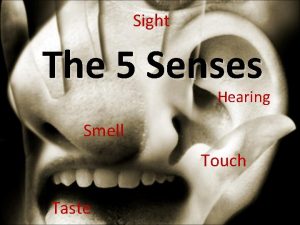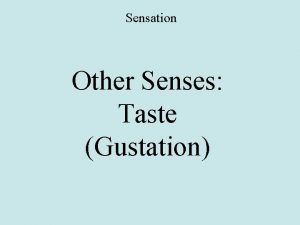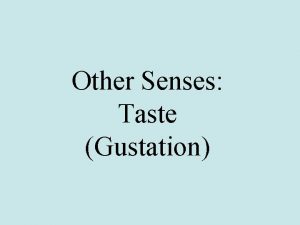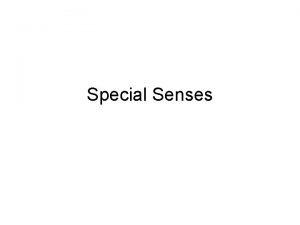REVIEW PACKET 1 SENSES INTRO TOUCH TASTE SMELL
































- Slides: 32

• REVIEW PACKET # 1 SENSES INTRO TOUCH TASTE SMELL

Proprioceptors sense changes in the what? the tension of muscles and tendons

Baroreceptors detect changes in. blood pressure

What sense are these receptors used for? olfactory

There are five types of sensory receptors. Name three. . chemoreceptors pain receptors thermoreceptors mechanoreceptors photoreceptors

u. Chemoreceptors respond to. u. Pain receptors respond to u. Thermoreceptors respond to u. Mechanoreceptors respond to u. Photoreceptors respond to What stimulus does each receptor respond to? üChemoreceptors respond to changes in chemical concentrations. üPain receptors respond to tissue damage. üThermoreceptors respond to temperature changes. üMechanoreceptors respond to mechanical forces. üPhotoreceptors respond to light energy.

Does this describe a sensation or a perception? a feeling that occurs when the brain interprets sensory impulses; depend on which region of the cerebral cortex receives the impulse. A sensation

Name the entire structure. Taste bud

General senses are those whose sensory receptors are associated with what body areas? (name 3) skin muscles joints viscera

Three groups of somatic senses are üExteroceptive senses include senses of touch, pressure, temperature, and pain. üProprioceptive senses include senses associated with changes in muscles and tendons and in body position. üVisceroceptive senses include senses associated with changes in viscera.

Name three types of receptors responsible for the senses of touch and pressure. üFree nerve endings are located in epithelial tissues and are responsible for the sensation of itching. üMeissner’s corpuscles are located in hairless portions of skin and are involved in fine touch, as in distinguishing between two points on the skin. üPacinian corpuscles are located in deeper subcutaneous tissues of the hands, feet, penis, clitoris, urethra, breasts, and tendons and ligament, and are associated with heavier pressure, stretch, and vibrations.

Temperatures above 45 o. C and below 10 o. C activate _____receptors. pain

Which of the following cannot block pain in the brain? § endorphin § enkephalin § acetylcholine § serotonin § acetylcholine

Of the following, which can least likely undergo adaptation? • Thermoreceptors • Mechanoreceptors • photoreceptors • Pain receptors pain

. Heavy pressure and vibrations stimulate ________. • proprioceptors • baroreceptors • Meissner's corpuscles • Pacinian corpuscles

. The _____ are the actual areas that respond to chemical stimulations for the sense of smell. • olfactory lobes • olfactory mucous membrane cells • cilia on olfactory cells • olfactory organs • cilia on olfactory cells

. The gustatory cortex is located within the _____ temporal parietal occipital frontal parietal

. Sensory adaptation occurs when stimuli become _____. gradually ignored

Name these Stretch Receptors Muscle spindles – in skeletal muscles Golgi tendon organs – in tendons Copyright © The Mc. Graw-Hill Companies, Inc. Permission required for reproduction or display. Sensory nerve fiber Tendon Skeletal muscle fiber Connective tissue sheath (a) (b) 1919

What does this “map” indicate? Areas of referred pain Copyright © The Mc. Graw-Hill Companies, Inc. Permission required for reproduction or display. Liver and gallbladder Lung and diaphragm Liver and gallbladder Heart Stomach Pancreas Small intestine Appendix Ovary (female) Colon Kidney Ureter Urinary bladder 20

What causes Referred Pain? • May occur due to sensory impulses from two regions following a common nerve pathway to brain Copyright © The Mc. Graw-Hill Companies, Inc. Permission required for reproduction or display. Liver and gallbladder Lung and diaphragm Liver and gallbladder Heart Stomach Pancreas Small intestine Appendix Ovary (female) Colon Kidney Ureter Urinary bladder 21

Name these Touch and Pressure Receptors Free nerve ending (a) Tactile (Meissner’s) corpuscle (touch receptor (b) (c) b, c: © Ed Reschke ) Lamellated (Pacinian) corpuscle (pressure receptor) 22

Pain receptors are distributed widely throughout the skin and internal tissues, but are lacking where in the body? Nervous tissue of brain

What are these bumps on the tongue called? papillae

What stimulates Pain receptors? Damage to tissues

A nociceptor is a type of _____ receptor. pain

Odors sometimes alter our moods because sensory input from olfaction is routed through this part of the brain. Limbic system

• Where would you find these main kinds of proprioceptors in the body • Pacinian corpuscles • Muscle spindles • Golgi tendon organs • Pacinian corpuscles – in joints • Muscle spindles – in skeletal muscles* • Golgi tendon organs – in tendons

The bumpy surface of the tongue is actually made of peglike projections called _______. papillae

Name the sensors. • Simplest receptors • Sense itching • Abundant in hairless portions of skin and lips • Detect fine touch; distinguish between two points on the skin Free nerve endings Tactile (Meissner’s) corpuscles • Common in deeper subcutaneous. Lamellated tissues, tendons and ligaments (Pacinian) • Detect heavy pressure and corpuscles vibrations

The tip of the tongue is very sensitive to which taste sensation(s)? Both sweet AND salty

Name one of the body’s natural Pain inhibiting substances: Enkephalins Serotonin Endorphins
 Facts about taste
Facts about taste Beach side sight
Beach side sight Flow chart of taste and smell
Flow chart of taste and smell What is the difference between somatic and special senses
What is the difference between somatic and special senses Special vs general senses
Special vs general senses 5 taste senses
5 taste senses Good touch bad touch points
Good touch bad touch points Pvnt neurology
Pvnt neurology Crude touch
Crude touch Book review intro
Book review intro Ap government unit 1 study guide
Ap government unit 1 study guide Review packet section 1 factoring
Review packet section 1 factoring Final exam review packet spanish 1 and spanish 2 answer key
Final exam review packet spanish 1 and spanish 2 answer key World history 1 sol review
World history 1 sol review Algebra 1 keystone review packet
Algebra 1 keystone review packet Geometry sol review packet
Geometry sol review packet Geometry sol review packet
Geometry sol review packet World history semester 2 final review packet
World history semester 2 final review packet Spanish 2 review packet
Spanish 2 review packet Biology keystone review packet answer key
Biology keystone review packet answer key Final exam review algebra 1
Final exam review algebra 1 Biology keystone review packet answer key
Biology keystone review packet answer key Biology keystone review packet
Biology keystone review packet Living environment review packet
Living environment review packet Dna review packet
Dna review packet State-of-being verbs
State-of-being verbs Smell of apple
Smell of apple What does cornstarch smell like
What does cornstarch smell like Code smell
Code smell Code smell bloaters
Code smell bloaters Do owls have a sense of smell
Do owls have a sense of smell Once there was a boy who was so lazy
Once there was a boy who was so lazy Sharks can smell blood from how far
Sharks can smell blood from how far


